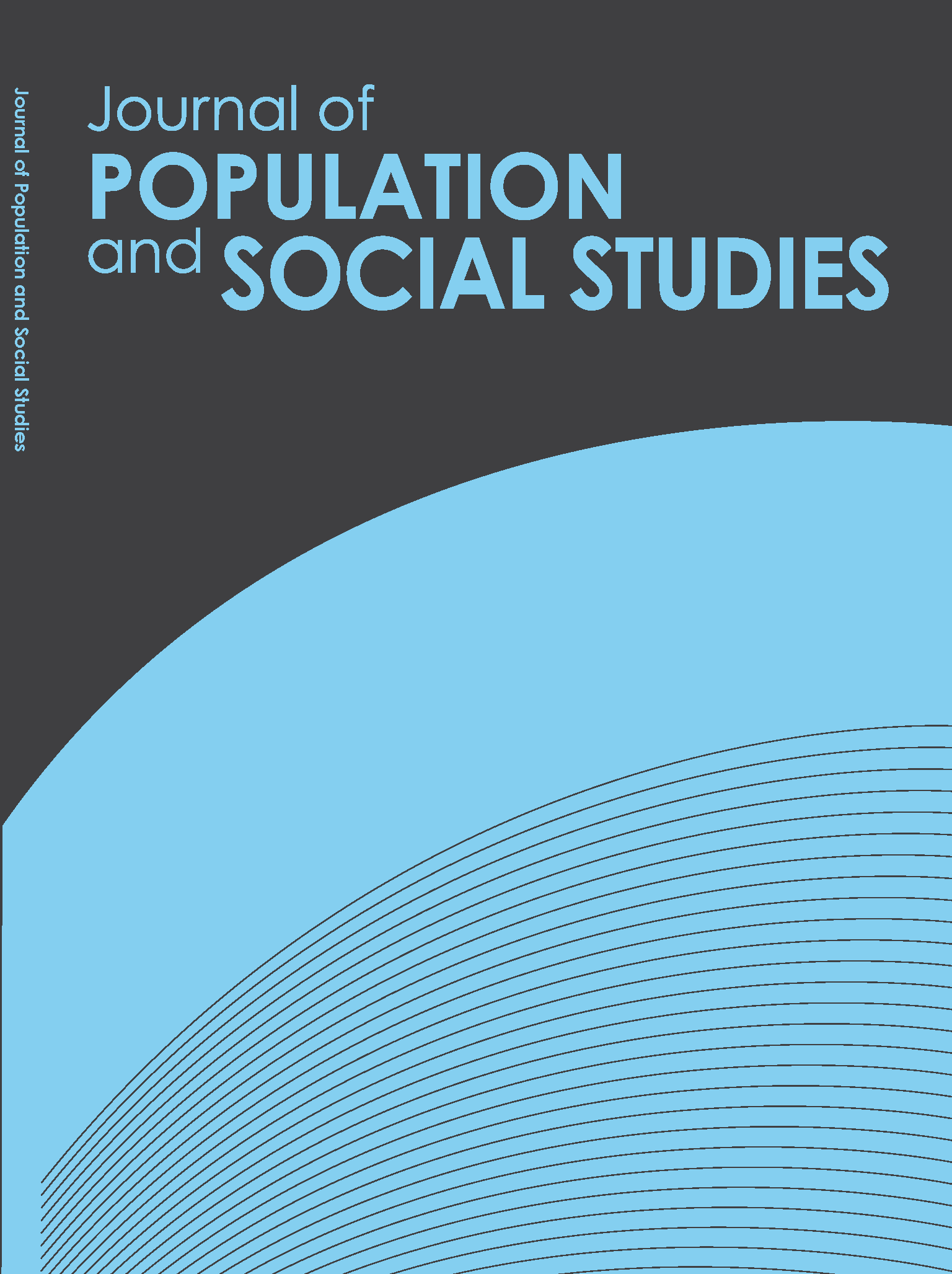Verification of Reported Age of Centenarians in Thailand
Main Article Content
Abstract
The objectives of this study were to verify the number of Thai centenarians based on the Thai population registration database and to study the causes for an upward bias of age reporting among centenarians. A phone-based sample survey was conducted with key informants to compare registration data with the de facto number of living centenarians. A sample of presumed centenarians in a sub-set of Thailand’s 76 provinces was selected to confirm the existence of the centenarians, along with their age, and to explain any discrepancies with registration data. This study found that among 358 recorded centenarians, only 53 (15%) were found to be still alive at the time of data collection. Among those who were still alive, 45 were contacted in person, with only 20 (44.4%) confirmed to be centenarians (i.e., age of 100 years or older). Older persons tend to misreport their age, usually with an upward bias, or the inaccuracy could be from an erroneous entry of the date on the birth certificate or household registration book. Furthermore, non-notification of death was the leading reason for not discharging deceased persons from registration data, thus contributing to an over-count of living centenarians. Based on the findings of this study, the authors provide recommendations for improving the quality of the population registration data, especially for Thailand’s centenarians, and guidelines for future related research.
Article Details
References
• Balistreri, C. R., Candore, G., Accardi, G., Buffa, S., Bulati, M., Martorana, A., … Caruso, C. (2014). Centenarian offspring: a model for understanding longevity. Current Vascular Pharmacology, 12(5), 718–725. https://doi.org/10.2174/1570161111666131219113544
• Chamratrithirong, A., Debavalya, N., & Knodel, J. (1978). Age reporting in Thailand: Age at last birthday versus age at next birthday. Institute of Population Studies, Chulalongkorn University.
• Chuanwan, S., Prasartkul, P., Chamratrithirong, A., Vapattanawong, P., & Hirschman, C. (2012). Incompleteness of registration data on centenarians in Thailand. Journal of Population and Social Studies, 20 (2), 38-54. https://so03.tci-thaijo.org/index.php/jpss/article/view/84521
• Department of Provincial Administration. (1999). Manual of practicing on population registration 1999. Bangkok: Department of Provincial Administration, Ministry of Interior (in Thai).
• Department of Provincial Administration. (2020). Official Statistics Registration System. https://stat.bora.dopa.go.th/stat/statnew/statINTERNET/#/
• Dublin, L. I., & Lotka, A. J. (1949). Length of Life. New York: Ronald Press.
• Gondo, Y., Hirose, N., Yasumoto, S., Arai, Y., & Saito, Y. (2017). Age verification of the longest-lived man in the world. Experimental Gerontology, 99, 7-17. https://doi.org/10.1016/j.exger.2017.08.030
• Hill, K., Vapattanawong, P., Prasartkul, P., Porapakkham, Y., Lim, S. S., & Lopez, A. D. (2007). Epidemiologic transition interrupted: A reassessment of mortality trends in Thailand, 1980–2000. Int. J. Epidemiol, 36, 374-384. https://doi.org/10.1093/ije/dyl257
• Knodel, J., & Chayovan, N. (1991). Age and birth date reporting in Thailand. Asia-Pacific Population Journal, 5(2-3), 41-76. https://pubmed.ncbi.nlm.nih.gov/12343437/
• Motta, M., Bennati, E., Ferlito, L., Malaguarnera, M., Motta, L., & Italian Multicenter Study on Centenarians (IMUSCE) (2005). Successful aging in centenarians: myths and reality. Archives of Gerontology and Geriatrics, 40(3), 241–251. https://doi.org/10.1016/j.archger.2004.09.002
• Office of the National Economic and Social Development Council. (2019). Population Projections for Thailand 2010-2040, revised. Bangkok: Office of the National Economic and Social Development Council.
• Perls, T. T., Bochen, K., Freeman, M., Alpert, L., & Silver, M. H. (1999). Validity of reported age and centenarian prevalence in New England. Age Ageing, 28(2), 193-197. https://doi.org/10.1093/ageing/28.2.193
• Prasartkul, P., & Chuanwan, S. (2006). Utilization of civil registration data to study demography of centenarians. Paper presented at the 2006 Thai National Symposium on Population Studies, Bangkok.
• Prasartkul, P., & Vapattanawong, P. (2006). The completeness of death registration in Thailand: Evidence from demographic surveillance system of the Kanchanaburi Project. World Health & Population, 8(3), 43-51. https://doi.org/10.12927/whp.2006.18054
• Preston, S., & Hill, K. (1980). Estimating the completeness of death registration. Population Studies, 34(2), 349-366. https://doi.org/10.2307/2175192
• Robine, J. M., Saito, Y., & Jagger, C. (2009). The relationship between longevity and healthy life expectancy. Quality in Ageing and Older Adults, 10(2), 5-14. https://doi.org/10.1108/14717794200900012
• Rosenwaike, I., & Stone, L. F. (2003). Verification of the Ages of Supercentenarians in the United States: Results of a Matching Study. Demography, 40(4), 727-739. https://doi.org/10.2307/1515205
• Rukumnuaykit, P. (2006). Mortality and causes of death in Thailand: Evidence from the survey of population change and death registration. Asia-Pacific Population Journal, 21(2), 67-84. https://doi.org/10.18356/2702b8d0-en
• Saito, Y., Yong, V., & Robine, J. M. (2012). The mystery of Japan’s missing centenarians explained. Demographic Research, 26(11), 237-252. https://dx.doi.org/10.4054/DemRes.2012.26.11
• Siegel, J. S., Swanson, D., & Shryock, H. S. (2004). The methods and materials of demography. Elsevier Academic Press.
• Tangcharoensathien, V., Faramnuayphol, P., Teokul, W., Bundhamcharoen, K., & Wibulpholprasert, S. (2006). A critical assessment of mortality Statistics in Thailand: Potential for improvements. Bulletin of the World Health Organization, 84, 233-238. https://doi.org/10.2471/blt.05.026310
• Thatcher, R. (1999). The demography of centenarians in England and Wales. Population Trends, (96), 5-12.
• The Foundation of Thai Gerontology Research and Development Institute. (2016). Situation of the Thai Elderly 2015. Bangkok: The Foundation of Thai Gerontology Research and Development Institute.
• United Nations, Department of Economic and Social Affairs, Population Division (2019). World Population Prospects 2019: The 2019 Revision. https://population.un.org/wpp/DataQuery/
• Vapattanawong, P., & Prasartkul, P. (2011). Under-registration of deaths in Thailand in 2005–2006: Results of cross-matching data from two sources. Bulletin of the World Health Organization, 89, 806-812. https://doi.org/10.2471/blt.10.083931
• Willcox, D. C., Willcox, B. J., He, Q., Wang, N. C., & Suzuki, M. (2008). They really are that old: A validation study of centenarian prevalence in Okinawa. J Gerontol A Biol Sci Med Sci, (4)63, 338-349. https://doi.org/10.1093/gerona/63.4.338
• World Health Organization. (2012). Life expectancy at birth. https://www.who.int/whosis/whostat2006DefinitionsAndMetadata.pdf
• Yi, Z. (2008). Reliability of age reporting among the Chinese oldest-old in the CLHLS Datasets. In Z. Yi, D. Poston, Jr., D. Vlosky, & D. Gu (Eds.), Healthy longevity in China (Vol. 20, pp. 61-78). Springer Netherlands. https://doi.org/10.1007/978-1-4020-6752-5_4


